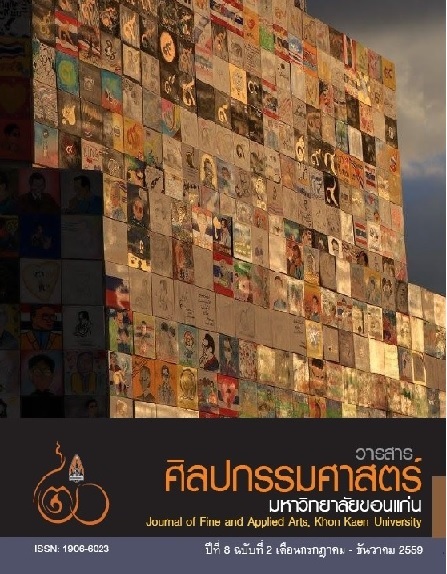อนุสาวรีย์: ภาพสะท้อนด้านอัตลักษณ์ ประวัติศาสตร์ การเมือง และความสัมพันธ์ ใน สาธารณรัฐประชาธิปไตย ประชาชนลาว The Reflection of Identity, Historical, Politics and ImplicationFrom Monuments in Lao Peoples Democratic Republic
Main Article Content
Abstract
บทความเรื่อง อนุสาวรีย์: ภาพสะท้อนด้านอัตลักษณ์ ประวัติศาสตร์ การเมือง และ ความสัมพันธ์ ในสาธารณรัฐประชาธิปไตย ประชาชนลาว มีจุดประสงค์ในการศึกษา 1) เพื่อศึกษาประวัติความเป็นมาของอนุสาวรีย์ในสาธารณรัฐประชาธิปไตยประชาชนลาว 2) เพื่อศึกษาสภาพปัจจุบันของอนุสาวรีย์ใน สาธารณรัฐประชาธิปไตยประชาชนลาว 3) เพื่อศึกษาภาพสะท้อนของอนุสาวรีย์ ด้านอัตลักษณ์ ประวัติศาสตร์ การเมืองและความสัมพันธ์ใน สาธารณรัฐประชาธิปไตยประชาชนลาว การศึกษาครั้งนี้เป็นการศึกษาโดยใช้กระบวนการวิจัยเชิงคุณภาพ โดยใช้ข้อมูลภาคสนามเป็นหลักและวรรณกรรมทั้งในประเทศและต่างประเทศเป็นส่วนประกอบ เป็นการศึกษาโดยใช้กระบวนการวิจัยเชิงคุณภาพ โดยมีกลุ่มตัวอย่างที่ใช้ในงานวิจัยในสาธารณรัฐประชาธิปไตยประชาชนลาว ได้แก่ กลุ่มผู้รู้ กลุ่มผู้ปฏิบัติ และกลุ่มผู้เกี่ยวข้อง ได้มาโดยการเลือกแบบเจาะจง เครื่องมือที่ใช้ในการวิจัย ประกอบด้วยแบบสำรวจ แบบสังเกต แบบสัมภาษณ์ การสนทนากลุ่มและการประชุมเชิงปฏิบัติการ แล้วนำมาวิเคราะห์ด้วยทฤษฎีโครงสร้างหน้าที่นิยม ทฤษฎีทางสุนทรียศาสตร์ และทฤษฎีสัญลักษณ์ นำเสนอผลการวิจัยด้วยการพรรณนาวิเคราะห์ และประกอบภาพถ่าย จากการศึกษาพบว่า อนุสาวรีย์ในสาธารณรัฐประชาธิปไตยประชาชนลาว นั้นมีประวัติความเป็นว่ามีการสร้างขึ้นมานานนับตั้งแต่สมัยเก่าหรือยุคหินใหญ่ ซึ่งเป็นวัฒนธรรมที่มีการพัฒนาขึ้นในสมัยสังคมชนเผ่า มีวัตถุประสงค์ในการสร้างเพื่อปกป้องผู้ตาย หรือเป็นอนุสรณ์ อุทิศส่วนกุศลให้แก่ผู้ตาย มักสร้างเป็นผลงานออกมาในรูปแบบที่แตกต่างกันออกไป อาทิ ไหหิน หินตั้ง ตั้งหิน โรงหิน หลุมศพที่ก่อด้วยแท่นหิน โดยปรากฏอนุสาวรีย์ในหลายพื้นที่ ได้แก่ ไหหินที่เชียงขวาง หินตั้งที่ชำเหนือ หินตั้งที่หลวงน้ำทา หินตั้งที่หลวงพระบาง รวมทั้งโรงศพหิน หรือหลุมศพหินที่พบตามถ้ำและภูเขาต่าง ๆ ในหลายแห่ง สมัยกลางพบว่า นิยมสร้างเป็นพระธาตุ หรือเจดีย์เป็นหลัก อาทิ พระธาตุของพระพุทธเจ้า กษัตริย์ อาวาส รวมไปถึงธาตุที่สร้างอุทิศส่วนกุศลให้กับพ่อแม่ ปู่ย่า ตายาย หรือผู้มีพระคุณที่ได้ล่วงลับไปแล้ว ส่วนในสมัยปัจจุบัน ได้มีพัฒนาการการสร้างอนุสาวรีย์ให้เป็นรูปเหมือนของบุคคลสำคัญทั้งครึ่งตัวและเต็มตัวมากขึ้น ซึ่งปรากฏอนุสาวรีย์อยู่ทางภาคเหนือ มี 67 แห่ง ประกอบด้วย อนุสาวรีย์ด้านประวัติศาสตร์ 1 แห่ง ด้านการเมือง 62 แห่ง และ ด้านความสัมพันธ์ 4 แห่ง ภาคกลาง มี 76 แห่ง ประกอบด้วย อนุสาวรีย์ด้านประวัติศาสตร์ 5 แห่ง ด้านการเมือง 68 แห่ง และ ด้านความสัมพันธ์ 3 แห่ง และ ภาคใต้มี 33 แห่ง ประกอบด้วย อนุสาวรีย์ ด้านการเมือง 31 แห่ง และด้านความสัมพันธ์ 2 แห่ง เท่านั้น
ส่วนภาพสะท้อนด้านอัตลักษณ์ ประวัติศาสตร์ การเมือง และความสัมพันธ์ ในสาธารณรัฐประชาธิปไตยประชาชนลาว นั้นพบว่า ด้านอัตลักษณ์แสดงออกถึงความเรียบง่าย ซื่อ บริสุทธิ์ ด้านประวัติศาสตร์สะท้อนให้เห็นถึง ความเจริญรุ่งเรืองทางด้านทัศนศิลป์ในยุคสมัยต่าง ๆ ที่อุดมไปด้วยชีวิตจิตใจขนบธรรมเนียมประเพณี วัฒนธรรมของชาติลาว ในยุคสมัยนั้นๆ ด้านการเมือง สะท้อนให้เห็นถึงการต่อสู้ การเปลี่ยนแปลง ด้านความสัมพันธ์สะท้อนให้เห็นถึงความร่วมมือ ความสมัครสมานสามัคคี ความเป็นอันหนึ่งอันเดียวกันของประชากรและความร่วมมือกับประเทศเวียดนามในการต่อสู้ เพื่อเป็นการดำรงไว้ซึ่งความเป็นชาติของตนเอง
The study of The Reflection of Identity, Historical, Politics and Implication from
Monuments in Lao People’s Democratic Republic aimed to find the history and background,
current status, and reflection, identity, history, politics and implication of monuments in Laos. This qualitative study mainly used data collected via field study trips, and domestic and international literature as a component. The sample groups were key informants, casual informants, and general informants in Laos which were selected by purposive sampling. The tools used include survey, observation, interview, focused - group discussion and workshop. The data collected then was analyzed by using Structural Functionalism, Theory of Aesthetics, and Theory of Symbolism. The study is presented in a descriptive analysis accompanying with photographs.
The study reveals that the monuments in Lao People’s Democratic Republic were historically established since the Old Stone Age or Big Stone Age, which was the culture developed in period of tribe society. The monuments were constructed with an objective to protect the dead or as commemoration of good merits to the dead. The monuments were normally made in various styles and types, such as stone jars, stone stands, standing stones, and stone coffins and graves. These monuments were found in various areas, including stone jars found in Xieng Khouang, stone stands found in Chamnua, standing stones in Luang Namtha, stone stands in Luang Prabang, stone coffins or stone graves found in caves and mountains. In the medieval age, it was found that the monuments were mostly constructed as a Phra That or stupa, such as Phra That or the relics of Buddha, kings, abbots, as well as those constructed as to dedicate merits to the spirits of those who had passed away, such as parents, grandparents or patrons. In these days, the monuments have been developed to construct as figures of important persons in both half and full body forms. There were total 67 monuments found in the northern Laos, including one of historical monument, 62 political monuments, and 4 implication (relation) monuments. In the central Laos, there were total 76 monuments found, consisted of 5 historical monuments, 68 political monuments, and 3 of implication monuments. In southern Laos, there were only 33 monuments found, including 31 political monuments and 2 implication monuments. In this study, the reflection of identity of monuments in Laos was simple, honest, and innocent, whereas the historical reflection was about the prosperity of visual arts in various periods which were rich of lives and tradition and culture of Lao in certain period of time. In the political reflection, it was found to be about fighting and changing of country’s ruling system. In the reflection of implication of monuments in Laos, it was revealed about the cooperation and unity of fighting against the two nations as to maintain their nationhood.
Article Details
Content and information in articles published in the Journal of Fine and Applied Arts of Khon Kaen University is regarded as the opinion and sole responsibility of the author(s) directly; therefore, editors are not obliged to agree to or share any responsibility with regard to the content and information that appears within these articles.
All articles, information, content, image, etc. that have been published in the Journal of Fine and Applied Arts of Khon Kaen University is the copyright of the Journal of Fine and Appllied Arts of Khon Kaen University. Any person or organization who wishes to distribute all or parts of the articles for further dissemination or other usage must first receive permission from the Journal of Fine and Applied Arts of Khon Kaen University before proceeding to do so.


